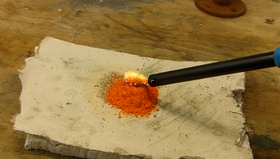Ammonium dichromate
 Ammonium dichromate being lit
| |
| Names | |
|---|---|
| IUPAC name
Ammonium dichromate
| |
| Other names
Ammonium bichromate
Ammonium pyrochromate Diammonium dichromate Vesuvian Fire | |
| Properties | |
| (NH4)2Cr2O7 | |
| Molar mass | 252.07 g/mol |
| Appearance | Orange crystalline solid |
| Odor | Odorless |
| Density | 2.115 g/cm3 |
| Melting point | 180 °C (356 °F; 453 K) (decomposition) |
| Boiling point | Decomposes |
| 18.2 g/100ml (0 °C) 35.6 g/100ml (20 °C) 40 g/100ml (25 °C) 156 g/100ml (100 °C) | |
| Solubility | Soluble in alcohols Insoluble in acetone |
| Hazards | |
| Safety data sheet | Sigma-Aldrich |
| Related compounds | |
| Related compounds
|
Potassium dichromate Sodium dichromate |
| Except where otherwise noted, data are given for materials in their standard state (at 25 °C [77 °F], 100 kPa). | |
| Infobox references | |
Ammonium dichromate is the inorganic compound with the formula (NH4)2Cr2O7.
Contents
[hide]Properties
Chemical
Ammonium dichromate decomposes when heated, releasing nitrogen, water vapors and green chromium(III) oxide particles in a manner similar to a volcanic eruption, hence why this property makes it widely used in various pyrotechnic demonstrations.
- (NH4)2Cr2O7 → Cr2O3 + N2 + 4 H2O
Physical
Ammonium dichromate is a red-orange solid, soluble in water and alcohols, but less so in other solvents.
Availability
Ammonium dichromate can be bought from various chemical suppliers. It can also be found on eBay and Amazon.
Since September 2017, ammonium dichromate is banned in EU.
Preparation
Ammonium dichromate can be made by reacting sodium dichromate (which in turn can be made by the action of sodium hypochlorite aka household bleach to chromium(III) hydroxide or oxide) with ammonium chloride. Since sodium chloride is more soluble than ammonium dichromate at low temperatures, cooling the solution will cause ammonium dichromate to crystalize out of the solution.
Projects
- Tabletop volcano
- Make chromium trioxide
- Source of nitrogen gas
- Make chrome alum
- Leather tanning
Handling
Safety
Ammonium dichromate is flammable, oxidizer and a known carcinogen
Storage
Ammonium dichromate should be kept in plastic containers, with a proper label and a hazard symbol. Keep it away from acids and open flame sources.
Disposal
Can be reduced to Cr(III) using aqueous solutions of ascorbic acid. Other reducing agents, such as sodium/potassium metabisulfite, sulfite, thiosulfate can be used.
Burning ammonium dichromate is not recommended, as small amounts of it will be spread in air.